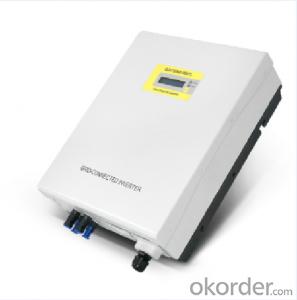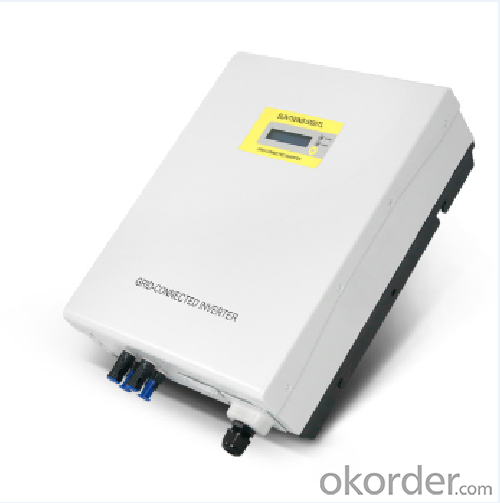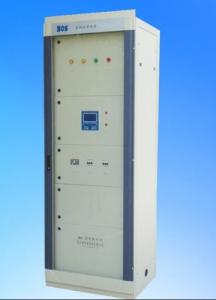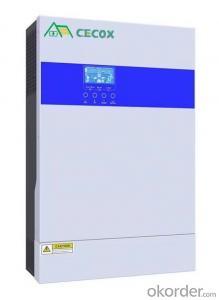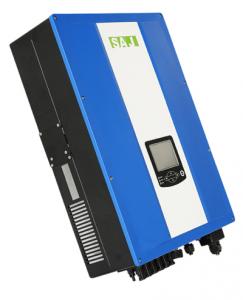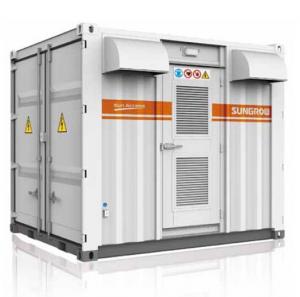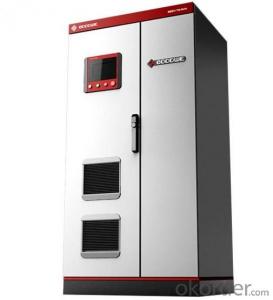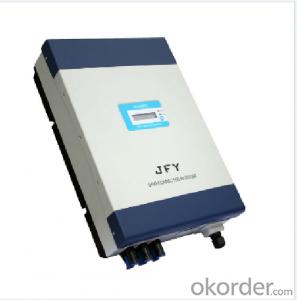Micro Solar Inverter 5kW 2MPPTs 5000TL On-Grid Inverter
- Loading Port:
- Qingdao
- Payment Terms:
- TT OR LC
- Min Order Qty:
- 50000 watt
- Supply Capability:
- 3000000 watt/month
OKorder Service Pledge
OKorder Financial Service
You Might Also Like
1. Structure of Solar On-grid Inverter 5kw 2MPPTs 5000TL Description
A solar inverter, or PV inverter, or Solar converter, converts the variable direct current (DC) output of a photovoltaic (PV) solar panel into a utility frequency alternating current (AC) that can be fed into a commercial electrical grid or used by a local, off-grid electrical network. It is a critical BOS–component in a photovoltaic system, allowing the use of ordinary AC-powered equipment. Solar inverters have special functions adapted for use with photovoltaic arrays, including maximum power point tracking and anti-islanding protection.
2. Main Features of the Solar On-grid Inverter 5kw 2MPPTs 5000TL
﹒2 MPPT channels, new generation technology
﹒Two high speed MPPT for real time power tracking and improved energy harvesting
﹒High frequency transformer operation for highest efficiency: 97.4% (97.0% Euro)
﹒Certified grid connected operation according to the international standards
﹒True Sine Wave Output
﹒ Integrated RS-485/RS-232 serial communication
﹒Multi-language display
﹒2 MPPT channels can be independent or parallel, auto detecting operation
3. Solar On-grid Inverter 5kw 2MPPTs 5000TL Images
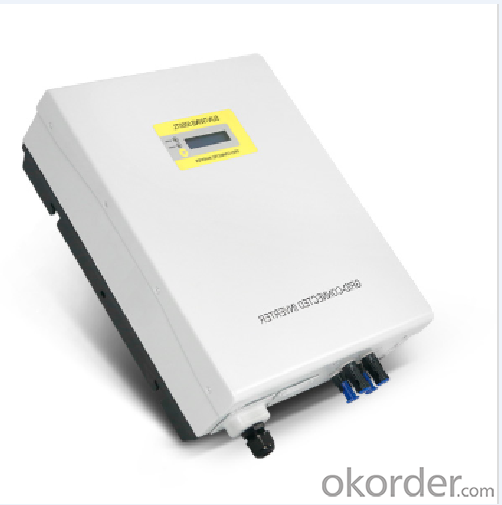
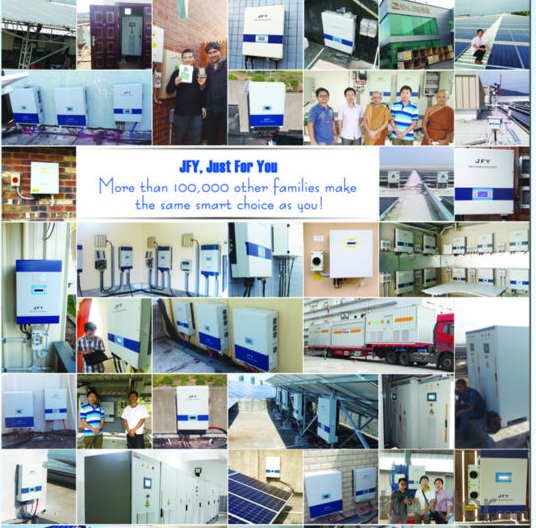
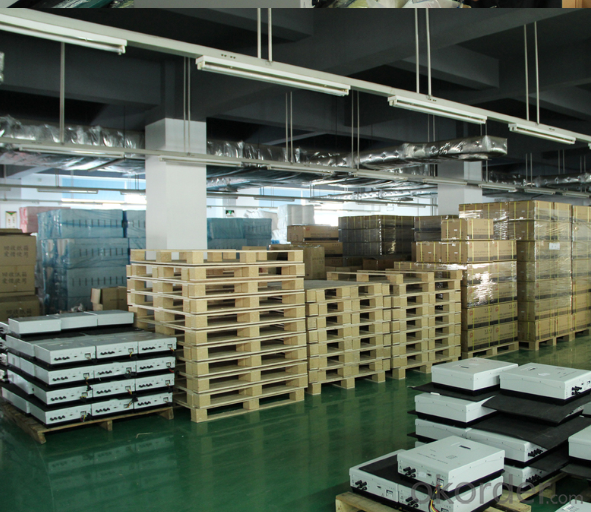

4. Solar On-grid Inverter 5kw 2MPPTs 5000TL Specification
CHARACTERISTICS | Suntwins 5000TL |
Input Data(DC side) | |
Max. DC power(Total) | 5300W |
Max.DC power per MPPT | 3000W |
Max. DC voltage | 500Vdc |
MPPT Operating range | 100~450Vdc |
Number of parallel inputs | 2 |
Number of MPPT trackers | 2 |
Max. input current per MPPT | IN1:15A/IN2:15A |
Output Data(AC side) | |
Nominal output power | 4950W |
Max. Output power | 4950W |
Nominal output current | 21.5A |
Max. output current | 25A |
Nominal AC voltage | 230Vac |
AC voltage range * | 190~265Vac |
Nominal AC grid frequency | 50Hz |
AC grid frequency range* | 50 ± 5 Hz |
Power factor(cos φ) | >0.99 |
Harmonic distortion(THDI) | <3%(at nominal output power) |
Efficiency | |
Max. efficiency | 97.4% |
Euro efficiency | 97.0% |
MPPT efficiency | 99.6% |
Genaral data | |
Dimensions (W / D / H) | 345*152*435mm |
Net weight | 18Kg |
Operating temperature range | –25 °C ~ +60 °C |
Noise emission (typical) | ≤ 25 dB(A) |
Power consumption at night | 0 W |
Electrical isolation | No |
Cooling concept | Natural cooling |
IP Code | IP65 |
Communication | RS-232(RS485 is optional) |
5. FAQ of Solar On-grid Inverter 5kw 2MPPTs 5000TL
Q1. What is the difference between inverter and solar inverter?
A1. Inverter only has AC inpput, but solar inverter both connect to AC input and solar panel, it saves more power.
Q2. What is the difference between MPPT&PWM?
A2. MPPT has higher efficiency, it can track the max power point and won't waste energy.
Q3. What is the waranty of product?
A3. 12 months.
- Q: Can a solar inverter be used in standalone power systems?
- Yes, a solar inverter can be used in standalone power systems. Standalone power systems, also known as off-grid systems, are not connected to the main electricity grid and rely on alternative energy sources like solar panels. A solar inverter converts the direct current (DC) generated by the solar panels into usable alternating current (AC) electricity, which can power various electrical devices in standalone power systems.
- Q: How does a solar inverter handle grid synchronization during startup?
- A solar inverter handles grid synchronization during startup by employing advanced control algorithms. It continuously monitors the grid voltage and frequency, aligns itself with the grid parameters, and gradually increases its output power to match the grid. This synchronization process ensures that the solar inverter seamlessly integrates with the grid and provides stable and synchronized power generation.
- Q: How is the output voltage of a solar inverter regulated?
- The output voltage of a solar inverter is regulated through a combination of voltage control algorithms and power electronics components. These algorithms continuously monitor the voltage level and adjust the inverter's operation accordingly to maintain a stable output voltage. Additionally, power electronics components like DC-DC converters and inverters are used to convert the variable DC voltage generated by the solar panels into a stable AC voltage output that matches the grid requirements.
- Q: What is the maximum current output of a solar inverter?
- The maximum current output of a solar inverter depends on its size and specifications. In general, smaller residential inverters may have a maximum output current of around 8-12 amps, while larger commercial or utility-scale inverters can go up to several hundred amps. It is important to select an inverter that matches the specific requirements of the solar PV system to ensure optimal performance and safety.
- Q: How does the temperature affect the performance of a solar inverter?
- The temperature can significantly affect the performance of a solar inverter. As the temperature increases, the efficiency of the inverter decreases. This is because the internal components of the inverter can overheat, leading to a decrease in power conversion efficiency. Additionally, high temperatures can also cause voltage drops and create thermal stress on the components, which can further impact the performance and longevity of the inverter. Therefore, it is crucial to consider temperature management and cooling mechanisms to ensure optimal performance and reliability of a solar inverter.
- Q: What is the role of a solar inverter in preventing islanding?
- The role of a solar inverter in preventing islanding is to constantly monitor the electrical grid and disconnect the solar system from the grid when a power outage occurs. By detecting changes in grid voltage or frequency, the inverter ensures that the solar system does not continue to generate and supply power to the grid in isolation, which could potentially cause safety hazards for utility workers and damage to electrical equipment.
- Q: Can a solar inverter be used in a solar-powered electric vehicle charging station?
- Yes, a solar inverter can be used in a solar-powered electric vehicle charging station. The solar inverter is responsible for converting the direct current (DC) generated by the solar panels into alternating current (AC) that can be used to charge electric vehicles. This allows the charging station to utilize the solar energy efficiently and power the charging process for electric vehicles.
- Q: What are the typical efficiency ranges for different types of solar inverters?
- The typical efficiency ranges for different types of solar inverters can vary depending on factors such as the technology used, the quality of the inverter, and the specific application. However, in general, string inverters typically have efficiency ranges of around 95% to 98%, while microinverters can achieve efficiencies ranging from 95% to 99%. On the other hand, central inverters, which are commonly used in large-scale solar installations, often have efficiency ranges of 97% to 99%. It's important to note that these are average ranges, and actual efficiency can vary depending on various factors and specific product specifications.
- Q: What is the role of a solar inverter in preventing electrical hazards?
- The role of a solar inverter in preventing electrical hazards is to convert the direct current (DC) electricity produced by solar panels into alternating current (AC) electricity that can be safely used in homes or businesses. It ensures that the electrical output from the solar panels is compatible with the electrical grid, reducing the risk of overloading or short circuits that can lead to electrical hazards such as fires or electrocution. Additionally, solar inverters have built-in safety features like ground fault protection and rapid shutdown mechanisms, which further minimize the chances of electrical accidents.
- Q: Can a solar inverter be used in extreme weather conditions?
- Yes, solar inverters are designed to withstand a wide range of weather conditions, including extreme heat, cold, humidity, and even harsh environmental factors. They are built to be durable and reliable, ensuring their functionality and performance in various climates and weather conditions.
Send your message to us
Micro Solar Inverter 5kW 2MPPTs 5000TL On-Grid Inverter
- Loading Port:
- Qingdao
- Payment Terms:
- TT OR LC
- Min Order Qty:
- 50000 watt
- Supply Capability:
- 3000000 watt/month
OKorder Service Pledge
OKorder Financial Service
Similar products
Hot products
Hot Searches
Related keywords
